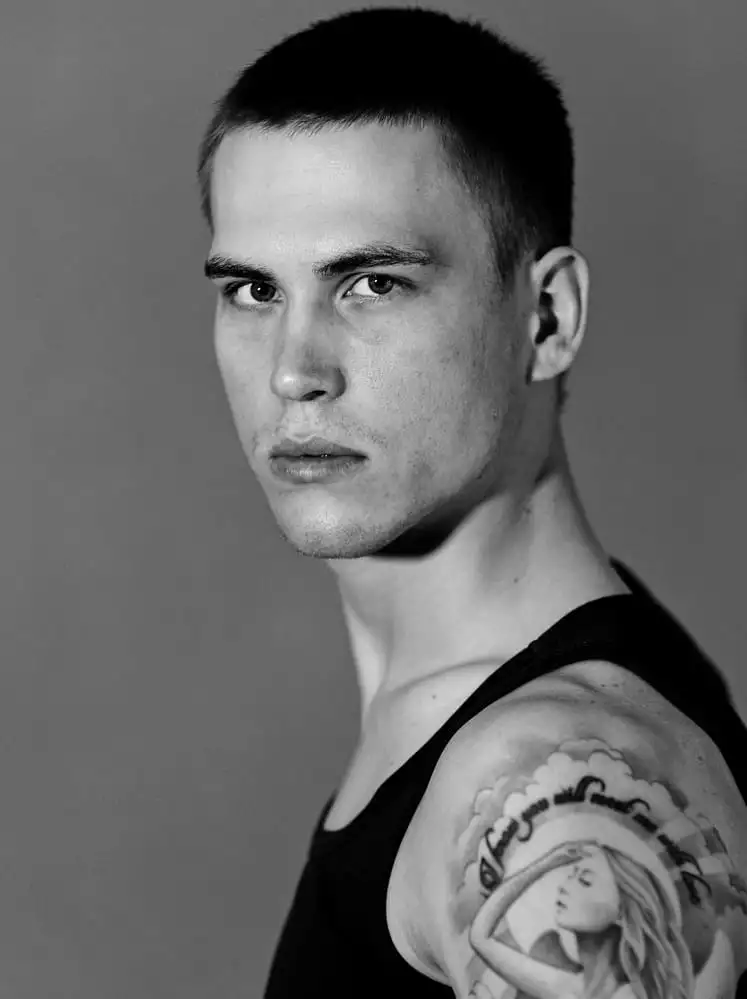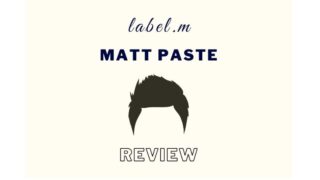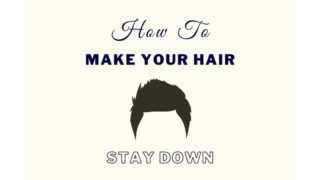When hairstyles are similar it can lead to some pretty serious misunderstandings between barbers and their clients. This is an important example. So, what’s the difference between crew cuts and buzz cuts?
Crew cuts have the hair on top scissor-cut and left longer than the clipped sides, graduating in length from the front to the back. In contrast, buzz cuts have the top, sides, and back clipped down to the same or very similar short lengths.
Let’s dig deeper so there’s no chance you end up with a hairstyle you didn’t want due to confusion.
After going through the differences between crew cuts and buzz cuts in more detail, we’ll talk through exactly how to choose which one of the two is right for you.
4 Differences Between Crew Cuts And Buzz Cuts
Here are four key differences between these two styles.
From the outset, it’s important to mention that the term “buzz cut” can sometimes be used to refer to a range of different short, clipper-dependent hairstyles including crew cuts, high and tights, and butch cuts.

As you can imagine, this could get confusing.
For the purposes of this article, we’re going to use the term “buzz cut” to refer to the most common type of buzz cut people think of – the “induction buzz cut”.
This is where all of the hair is clipped down to the same length (or nearly the same length) all over.
1. Contrast Between Top And Sides
A crucial difference between crew cuts and buzz cuts is how the top and the sides relate to each other.
Crew cuts have a contrast between the top and the sides, while buzz cuts do not.
With crew cuts, the top, while still upright and relatively “short”, is left longer than the sides in comparison.
The top is usually scissor-cut.
The sides are clipped down short from the bottom to the top.
Unlike undercuts, the transition from the short sides to the longer hair on top is gradual. The sides blend into the top seamlessly with no harsh lines.
Unlike crew cuts, buzz cuts have the top, sides, and back clipped or “buzzed” down to the same (or very similar) short and even length in all directions and dimensions.

From Shutterstock
While you can taper or fade the sides with regular, induction-style buzz cuts, the difference between the sides and the top is still minimal.
There’s barely any contrast between the top and sides with buzz cuts. It all looks even or nearly-even.
2. Graduation At The Top
With crew cuts, the hair on top graduates in length from the front to the back. In contrast, buzz cuts have the hair on top at an even length.
To “graduate” the hair means to gradually reduce the length.
With crew cuts, the longer hair on top is graduated in length from the front to the back.
What this means is that you’re left with longer hair at the front than you do at the back, at least to a certain extent.
The longer hair at the front can be rounded off so that it looks like a short pompadour from a side profile. Alternatively, it can be relatively flat.
But taking the natural shape of the head into consideration, from the side, a crew cut will look quite horizontal thanks to this tapering of length from the front to the back.
Buzz cuts, on the other hand, do not have any tapering of length at the top. The length will be the same from the front to the back.
As a result, from a side profile, it often doesn’t look horizontal, because the appearance of the hair will take on the natural shape of the head. This isn’t horizontal.
3. Tapered Sides
Crew cuts almost always incorporate tapered or faded sides. It’s a well-recognized component of the style. In contrast, buzz cuts may or may not have tapered sides.
Short, tapered sides are important when it comes to crew cuts. It’s one of the reasons why the style has such a great balance.
“Tapered” or “faded” sides refer to the fact that the hair gradually increases in length from the bottom to the top with no harsh lines. The different lengths seamlessly blend into one another.
This is as opposed to simply clipping all of the hair at the sides down to the same, even length.
Tapering or fading the sides is more eye-catching. It also has a slimming effect on the face, defining the jawline.
Unlike crew cuts, buzz cuts don’t necessarily need tapered sides. There are plenty of buzz cuts where the sides are simply clipped down to the same length as the top, with no tapering at all.

DepositPhotos
Alternatively, you could get buzz cuts where the sides are slightly shorter than the top, but they aren’t faded.
Buzz cuts can work very well with tapers and fades, but the effect isn’t quite as obvious or noticeable as it would be with a crew cut in any case.
This is because there’s simply less of a contrast in length between the top and the sides, as we talked about in the first point.
The main point here is that crew cuts are very likely to have tapered sides, while buzz cuts don’t necessarily need tapered sides.
4. Required Tools
Crew cuts usually require some scissor-cutting to effectively taper the length of the hair at the top from the front to the back. A pair of clippers would still be required to taper the sides. Buzz cuts, on the other hand, can be done with a pair of clippers alone.
Buzz cuts can be thought of as a “simpler” style to trim than crew cuts for this reason.
In fact, they’re pretty easy to DIY, especially if you aren’t planning on tapering the sides.
Popping on a clipper guard and trimming down all of your hair to the same length in all directions is actually pretty easy to do yourself.
That’s the beauty of induction-style buzz cuts.
Crew cuts, in contrast, aren’t anywhere near as easy to DIY. In fact, trying to do it yourself would not be recommended.
Although the style is pretty simple as a whole, graduating the length of the hair on top does require some technical skill with a pair of scissors. You don’t want to get it wrong.
Blending the scissor-cut top with the tapered sides is also something you want to be done by a barber.
Crew Cut Vs Buzz Cut: How To Choose
When choosing between a crew cut and a buzz cut, consider the following factors.
1. Face Shape
Buzz cuts are generally best avoided by men with rounder or shorter face shapes, as the shortness of the hair on top can exaggerate it too much. Crew cuts would be a better option for them as you have enough hair on top to add some height.
Face shape is important when it comes to choosing your perfect haircut.

Although it’s important not to overthink things, considering your face shape when choosing between these two styles is a good way to go.
Oval, oblong, rectangular, diamond, and other “long” face shapes would be fine with or even benefit from the shortness of a buzz cut.
Crew cuts would be fine too – they have the benefit of choice here.
But people with rounder or shorter face shapes (eg. square) may have to be a little more careful.
Buzz cuts are notorious for exaggerating the shape of your face. This is because you barely have any hair on top. Because of this, you can’t add any real height or length in the form of a short quiff, for instance.
There simply isn’t enough hair there to allow you to do it.
When you’ve got a naturally round or short face shape, trimming a buzz cut could make it look rounder or shorter than it ever has done before. It can take you by surprise.
Rounder or shorter face shapes would be better off going for a crew cut instead of a buzz cut because you’ve still got some length up top to work with.
You won’t be able to do a huge amount with it as it’s still pretty short. But it may still be just enough to compensate for the roundness or shortness of the face.
2. Styling And Maintenance
Buzz cuts are better for people who don’t want to worry about having to style their hair. Crew cuts are slightly higher maintenance than buzz cuts as they often benefit from a little bit of styling product.
If you’re looking for a set-it-and-forget-it hairstyle where you really won’t need to do anything with it – buzz cuts are a great way to go.
It makes things much easier in that respect.
You won’t need to style it – there’s nothing there to style with. In addition, routines such as washing and drying become a cinch.
Ultimately, trimming a buzz cut can cut down the length of your morning routine significantly.
That’s not to say that crew cuts are high maintenance, by any means. Crew cuts are still short hairstyles that you really won’t need to do much with.
But with longer crew cuts, you’ll probably find that you still need to worry about flattening strays and flyaways.
You’ll probably benefit from applying a small amount of styling product to give it some texture and prevent it from looking too “flat”.
Some people prefer this to hair they can’t actually do anything with. Crew cuts actually give you some styling capability.
You can’t do much with it – but a short quiff or maybe a very subtle comb over would be possible.
Ultimately, if you’d rather have a hairstyle where you really don’t have to do anything to maintain it (other than regular trims), a buzz cut would be a better option than a crew cut.
Alternatively, if you like having the option of being able to style your hair – even if it’s just a little – a crew cut would be better than a buzz cut for you.
3. Ability To DIY
If you’re looking for a hairstyle that’s easy to trim yourself, choose a buzz cut over a crew cut. Buzz cuts are simple to do yourself, as long as you have a pair of clippers capable of doing the job.
Crew cuts usually require some scissor-cutting and tapering of length, both of which are tasks best left in the hands of a barber.
There’s something pretty liberating about cutting your own hair. There really aren’t many styles that’ll allow you to do it.
Buzz cuts are so simple – you just trim everything down to the same length. Even if you were to trim the sides and back down a clipper grade shorter than the top, it still isn’t that difficult to do yourself.
Sure, fading the sides will require the technical skill of a barber. But a buzz cut with no fade is quite simple to DIY.
You save on time and you save on cost.
If this appeals to you, consider going for a buzz cut instead of a crew cut.
Conclusion
The differences between buzz cuts and crew cuts are significant. So much so, that confusing the two could lead to you asking your barber for a cut you never wanted.
Hopefully, you’re now a lot less likely to make that mistake.
Consider the differences when making your choice between the two. There’s a good chance that one of them will suit you more than the other in some way.
Enjoy.
Ready Sleek founder. Obsessed with casual style and the minimalist approach to building a highly functional wardrobe. Also a fan of classic, vintage hairstyles.

![Crew Cut Vs Buzz Cut: What’s The Difference? [Photos]](https://www.readysleek.com/wp-content/uploads/2021/10/Crew-cut-vs-buzz-cut-720x405.jpeg)





